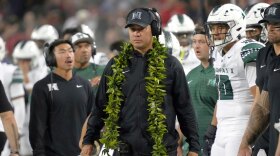New research from the University of Hawaiʻi about the benefits of protected marine areas is receiving international attention.
UH economics professor John Lynham noticed fishermen working near Papahānaumokuākea Marine National Monument found higher catch rates of tuna.
"They can benefit fishermen if there’s enough of a recovery inside the no-fishing zone that that starts to generate a spillover of fish beyond the boundaries of the protected area," Lynham said.
No-fishing zones give migratory fish like tuna a safe haven to mate and lay eggs. The growing fish population inside Papahānamokuākea spills over to nearby waters.

Fishing boats near the Northwestern Hawaiian Islands saw catch rates of big-eye tuna increase by 12% over the course of six years. The catch rate for yellowfin was even higher, rising by 54%.
While these numbers are significant, it doesn’t mean the tuna population is where it needs to be.
If the catch rate of yellowfin increased from half a catch per 1,000 hooks to one catch per 1,000 hooks, the catch rate is doubled. But Lynham says 30 years ago, local boats were catching 16 yellowfin per 1,000 hooks. The current rate is so low, a relatively small increase seems like a big percentage increase.
Although the tuna population is not at a sustainable level, the catch rate around Papahānamokuākea increases every year.

Lynham and co-authors Sarah Medoff and Jennifer Raynor received calls from people all over the world after publishing their findings in the journal Science.
"People all over the world are really interested in this research, and thinking about basically copying Hawaiʻi’s example to try to manage and protect their own migratory species like tuna," Lynham told HPR.
The article also received pushback — mostly from advocates of the fishing industry.
The team's next research will focus on the effects of dynamic closures, or temporary protected areas in the Pacific Ocean.
"I think this is a cool moment for Hawaiʻi because Hawaiʻi is basically a pioneer now in marine conservation and the protection of tuna, and the rest of the world is looking at Hawaiʻi and learning from that example," Lynham said.




